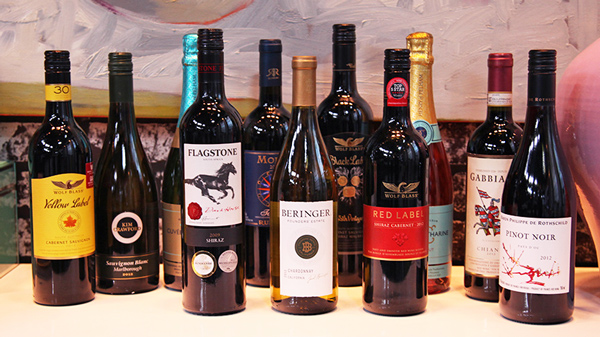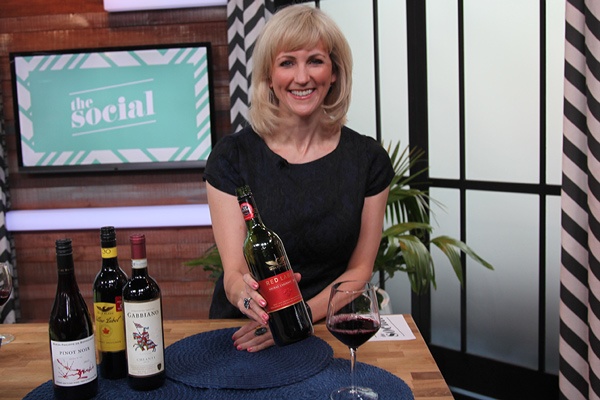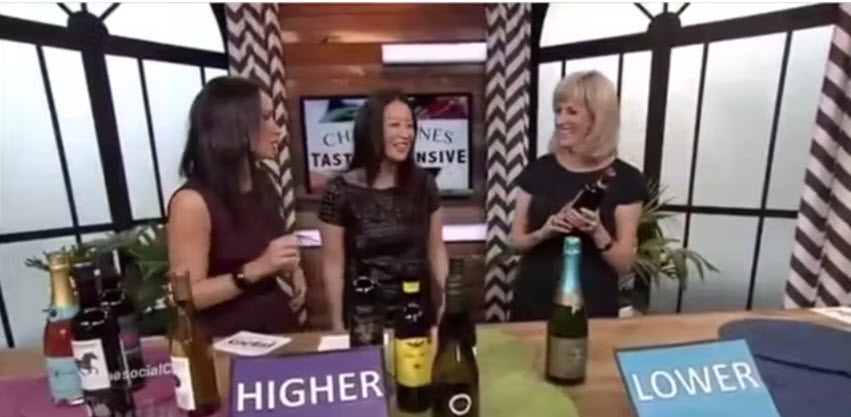In this segment of CTV’s The Social, we chat about how wines are priced: does a $100 wine taste ten times better than a $10 one?
How can you spot the bargains in the liquor store?
What clues can you find on the bottle label about quality and price?
You can get a shopping list with my top rated and best bargain wines showing the stock at your closest liquor stores when you join as a VIP Member.
Many of us love to shop and nearly all of us love a good bargain. But finding a Versace dress marked down 20 per cent in a warehouse outlet is much easier than finding a bargain wine in the liquor store. The dress you can try on; the wine can’t be tasted.
First things first, can you find a decent bottle of wine for $20? The answer is ‘yes’. More wineries and wine regions mean there’s increased competition. We also have better technologies in place, better winemaking techniques, and a better understanding of soil and climate. It all leads to more reasonably priced wine.

Once you begin your hunt for that bargain bottle, the best place to start is the label. You can try on a dress, read the first chapter of a book, but you usually can’t try the wine before you buy it. The label is your sole point of information. Eighty percent of wine is purchased by judging the label so you want to make sure you’re not fooled.
One of the first things you should look for is the winery. Are they reputable? Are they known for great value? A Chateaux Margaux is an excellent wine but at $600 a bottle, it’s not a great value. Don’t be misled by “badge” regions like Napa, Bordeaux, or Tuscany because they’re over-priced. Instead, look for great values from South Africa, Argentina, Chile, Germany and Canada.
Value can also be found in the grape. Cabernet and chardonnay are “badge” grapes whereas malbec, sauvignon, riesling and merlot are great values.
You also want to look for specifics on a wine label. The more information, the better. For example, a wine that is labeled as “Russian River, Sonoma County, California” is better than just “California.” More specific information can mean more attention paid to winemaking. Quality symbols from the winery’s region can also signify better adherence to quality standards (i.e. VQA for Ontario; DOC for Italy; AOC for France).
Ultimately, there are factors that contribute to the price of a wine that the consumer can’t control. But if you walk into a liquor store knowing these basic labelling rules, you’ll save your wallet and your taste buds.
You can watch the previous episode of The Social where we paired wine with fast food in a fun game show format. It’s as engaging and live-action as wine gets!

Photo credit: Sarah Robinson/TheSocial.ca
Wine Prices: Is the Price Right?
Cynthia: Welcome back!
Lainey: The only thing better than expensive wine is cheap wine that taste expensive. Who’s with me?
Cynthia: Amen to that sister. Now here to teach us how to spot a bargain in a bottle is sommelier and editor of Canada’s largest wine site, Natalie MacLean. Thanks for being here again.
Can we really get a good bottle of wine for under $20 that even wine snobs wouldn’t turn their nose up at?
Natalie: Absolutely, these days there’s so much competition for your wine dollar. There are more wineries than ever, there are more wine regions and technology is bringing the cost down. Of course winemakers know better how to handle the soil and grapes, so there’s not as much loss and that means we get better bargains.
Lainey: But what about the etiquette? Will I get busted for bringing over a $10 bottle of wine that is very, very good, over spending $25 on a bottle, I mean, will I be judged?
Natalie: Absolutely.
Lainey: I don’t want to be judged.
Natalie: Dumb money can spend $25 to $50 getting a decent bottle. It’s the smart money that finds the $10 or $12 dollar wine that everybody loves. Then, you can do the big reveal … guess what this cost?
Lainey: I can boast about being smarter.
Cynthia: This is good.
Lainey: Okay, You have it.
Cynthia: This is my technique for looking for a good bottle of wine; I look at just the label and how nice is the design. I know that’s not the right way. What are some things we need to look for to get a good quality bottle of wine?
Natalie: Well just so you know, 80% of wine is purchased based on the label so that’s all we have to go on. You can try on the dress or read the first chapter of a book but you can’t try the wine … at least not legally … before you buy it.
Cynthia: Right.
Natalie: There are some things that you can look for. For example, you want to look for a specific region.
Cynthia: Okay.
Natalie: What I mean by that is something that comes from Russian River or Sonoma County, California is more specific and has more rules and regulations and something that just says California.
Lainey: Okay.
Natalie: So that’s one thing to look for.
Cynthia: Okay so anything else that we should spot?
Natalie: In Canada we have something called VQA … Vintner’s Quality Alliance. It doesn’t promise you a better bottle but again more rules and regulations. It’s going to improve your chances.
Cynthia: Okay, is it a mistake that were are looking at wines and being a sucker for a label, in the same way we do with fashion that we’re going for label only?
Natalie: Absolutely, There are the Versace of wine regions. There’s Bordeaux, Tuscany, Napa Valley, etc. You’re going to pay for those badge regions just because they’ve made their reputation.
Lainey: Right.
Natalie: But you can find regions that are trying to establish a reputation or maybe they’re trying to repair a bad reputation from the 70’s or 80’s. Think Germany, South Africa, Argentina and Chile.
Lainey: So they’re like the knock-offs?
Natalie: The knock-offs.
Lainey: Oh yes, fine.
Natalie: Similarly, there are badge grapes such as Chardonnay or Cabernet. Look for the lesser known grapes – Malbec from Argentina if you like Cabernet or remember poor little Merlot that got the big hit from that movie “Sideways”.
Cynthia: Yes.
Lainey: Right.
Natalie: It tanked, so it went out of fashion. Pinot Noir soared. Pinot Noir still is more expensive but Merlot is a beautiful wine.
Cynthia: Very nice.
Lainey: I’m ready to label judge now.

Cynthia: We’re going to play a game; really quickly I just want to know can you settle this between a cork and a screw cap, once and for all?
Natalie: The screw cap, Yes, absolutely! So these days more fine wine is being bottled under a screw cap. You don’t get the cork taint which is something that makes your wine taste like wet cardboard in an attic, not good. With the screw cap you don’t need any special equipment. More and more wineries are doing it and on this table we have a hundred dollar bottle of wine under screw cap.
Cynthia: Oh my goodness, okay.
Lainey: Okay.
Natalie: So if you could guess which one.
Cynthia: Okay, so we’re going to play this game and see if we can take the information that Natalie just gave us and put it to good use. Using $20 as our price point, you and I are going to guess whether these wines are higher or lower than $20; these are all great wines, let’s just start with that.
Lainey: So one by one we’re going to grab a wine, we’re going to put it on the lower or the higher side, right? This is the higher, this is lower.
Cynthia: Okay.
Lainey: Help us out, above $20 or lower than $20?
Cynthia: You have 5 bottles.
Lainey: I don’t know. Horses … Mel loves horses. I’m going to put that over there.
Cynthia: Wait a minute, this one is Beringer it’s a Chardonnay, California. What do you guys think? It’s just kind of generic, right?
Cynthia and Lainey: Higher? Okay.
Lainey: This has gold on it.
Cynthia: Looks like Tiffany, tiffany blue.
Lainey: Tiffany colour so expensive?
Cynthia and Lainey: Higher? Lower?
Lower, okay and Gabbiano.
Cynthia: It’s a Chianti.
Lainey: This is a knight.
Cynthia: That looks nice, I would say higher, no it’s lower. I think it’s a lower one, I think it’s lower.
Lainey: Okay. How did we do?
Natalie: Let me just start with this one, Sparkling wine is hard to make so it’s more expensive, it is $30; let’s passed it over here.
Cynthia: Okay.
Lainey: Because of the Tiffany colour. Okay.
Natalie: Here you have a Modus. This may have led you astray. Toscana is Tuscany. There you go.
This is right.
Cynthia: I feel like I should take the responsibility in steering you off that one, right?
Natalie: This is correct. This is Tuscany as well but it’s Chianti and it’s a second label. Think Max Mara Weekend wear. This is Max Mara Weekend wear so this is about $16.
Lainey: Okay.
Natalie: That’s one is right.
Cynthia: Okay.
Lainey: I suck so how can I help?
Cynthia: Wolf Blass … Black Label it’s a vintage though, higher or lower? Higher? Okay, this one’s higher.
So let’s go with this one, I feel like I drink this all the time and I know already it’s lower.
Lainey: I bought this before, I feel like I bought it for under $20.
Cynthia: Okay, lower Wolf Blass.
Lainey: I think.
Cynthia: Kim Crawford Sauvignon Blanc Marlborough, lower or higher?
Lainey: I don’t know.
Cynthia: I don’t know. I’m going to go higher. And then last but not least, I see that we got…
Lainey: She just said that bubblies are expensive.
Cynthia: Higher? Okay.
Natalie: Right.
Cynthia: Done.
Natalie: Good job.
Cynthia: Really?
Natalie: Yes. Okay so this is a kind of a standard Yellow Label. You got it right on. Its $16-$17. Let’s see what else you did. People often get fooled by this because it’s Baron de Philippe Rothschild, they make six, seven hundred dollar bottles; this is their entry-level.
Cynthia: It’s good.
Natalie: There’s your weekend wear. And the rest over there are absolutely correct.
Lainey: Which one was the big gun? Which one was the boss?
Natalie: Do you want to guesses?
Cynthia: No, the Wolf Blass.
Lainey: It was the screw cap, right?
Natalie: Yes, yes, we have the Wolf Blass.
Cynthia: Wolf Blass?
Natalie: Yes it is.
Cynthia: I know my wines, mama drinks.
Natalie: Absolutely, so these I mean you can see the range here, $16 / $17 to 100 bucks.
Cynthia: There you go.
Lainey: Let’s raise a glass, Natalie, and cheers to your wisdom.
Natalie: Absolutely here we go.
Lainey: Okay, I just want to guess, under or over? Call it.
Cynthia: Under.
Lainey: Under 20?
Natalie: Yes.
Cynthia: Amazing.
Natalie: We’re going to taste a $15 wine, hope you think it tastes twice as expensive as it costs.
Lainey: Remember to checkout our tips on our website, thank you, Natalie.
Natalie: Cheers!
Lainey: And we’ll be right back.
Cynthia: Thank you so much.
Cynthia, Lainey & Natalie: Cheers!
Posted with permission from CTV.








